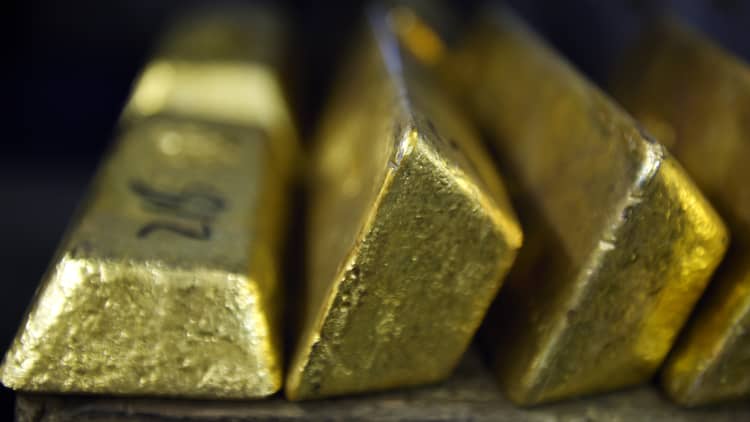A combination of continued geopolitical risk, a weaker dollar and negative real rates would continue gold's rally through 2020, commodity strategists anticipate.
However, there is some disagreement over the extent to which geopolitical factors will continue to be supportive for the precious metal.
Gold prices rallied to a seven-year high after tensions escalated in the Middle East following the U.S. killing of top Iranian military commander Qasem Soleimani, as investors flocked into typically safe assets, with oil and bond prices also surging.
As well as geopolitical risk, however, macro factors are also boosting gold's appeal as a hedge against uncertainty. A softened dollar and a persistent negative rate environment are chief among these gold-supportive trends.
Since gold is denominated in dollars internationally, weakness in the greenback pushes up gold prices and vice versa. Meanwhile negative real interest rates, in which the inflation rate is higher than the nominal interest, means that creditors will be losing money and are therefore more likely to park their money in gold.
Push toward $1,600
In a note published Tuesday, UBS commodity strategists Joni Teves and James Malcolm said their base case is for gold to trade through and average around $1,600 per ounce this year on the back of the aforementioned three factors. Spot gold was hovering at around $1,566 during European afternoon trade on Tuesday.
Gold is also stronger against other currencies, with anecdotal information suggesting that there is "some producer interest to take advantage of the gold price move in local currencies," Teves and Malcolm suggested.
"Producer selling might help rein in the rally in the near term, but we do not expect it to derail the broader uptrend especially if macro factors continue to move in gold's favor. On the flip side, softer (first quarter) data in the U.S. – as our economists expect – would be a tailwind for gold," the note added.

Colin Hamilton, managing director of commodities research at BMO Capital Markets, told CNBC on Tuesday that January and February are typically strong months due to a combination of physical demand in China ahead of the Lunar New Year holidays and a rebalancing of investor portfolios, particularly ETFs (exchange-traded funds).
"Coming out of Chinese new year will be a very important time, because that's when we will see the industrial economy measures, because we have actually seen a decent rally in the industrial economy and industrial equities for the past two or three months, probably a little bit ahead of fundamentals," Hamilton told CNBC's "Street Signs Europe."
"Now it's a case of whether we see the data coming out of China, which tends to lead the industrial cycle, back that up."
Hamilton also suggested that central bank purchases of gold could provide further momentum, particularly with central banks around the world looking to de-dollarize.
"There's still going to be Kazakhstan, Russia, China, who are still going to be net purchasers of gold — that's kind of like an annuity for the gold market," he said.

Delayed data from the U.S. Commodity Futures Trading Commission (CFTC) shows that speculators bought 20,251 lots of COMEX gold over the last reporting week, resulting in a net long position of 263,170 lots as of last Tuesday, the highest levels since September.
ING Head of Commodities Strategy Warren Patterson highlighted in a note Tuesday that the current speculative net long will likely be significantly larger given the flock to safe havens since Thursday night's killing of Soleimani. Long positions are where traders bet the price will rise, rather than fall.
Circumstantial considerations
Despite the broadly supportive environment for gold, however, strategists are also cautioning investors to avoid jumping the gun.
UBS noted that thin liquidity conditions are likely exaggerating price action, with traders only gradually returning to full swing following the holiday period, meaning extrapolating trends from sharp moves since the turn of the year remains a difficult proposition. The aforementioned seasonality of positive gold price action was cited as another key consideration.
Teves and Malcolm also expressed caution about the volatility and sustainability of the impact of geopolitical uncertainty on gold prices.
"Further escalation would likely see a ramp-up in safe haven demand for gold, but the bar for persistent and significant price responses tends to increase as the uncertainty drags on," they said in Tuesday's note, adding that de-escalation would swiftly unwind gains.
"A more sustained impact would be if the uncertainty considerably filters through to inflation and growth," the note projected.
Similarly, a note Tuesday from Macquarie commodity strategists cautioned that in isolation, "previous geopolitical risk events have been insufficient to deliver a sustained gold price rally."
"For prices to rally further, it would likely require some combination of general U.S. dollar weakness, lower interest rates and a spike in inflation expectations — via higher oil prices and/or concerns of a negative spill-over to global growth," the note said.
Contrary to recent price action, Macquarie retained its previous base case of a period of price consolidation against the wider backdrop of improving global risk sentiment outside of the Middle East.

